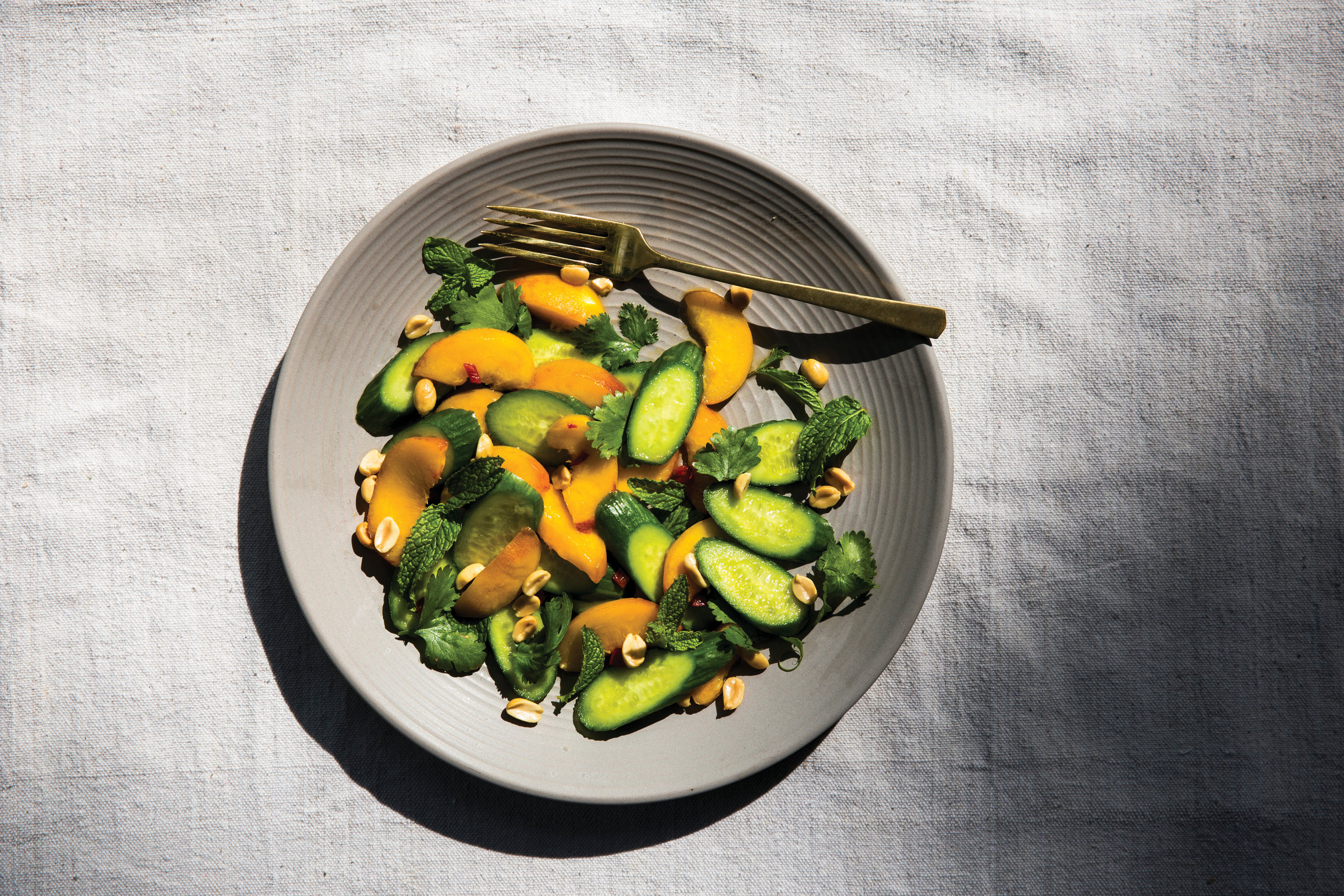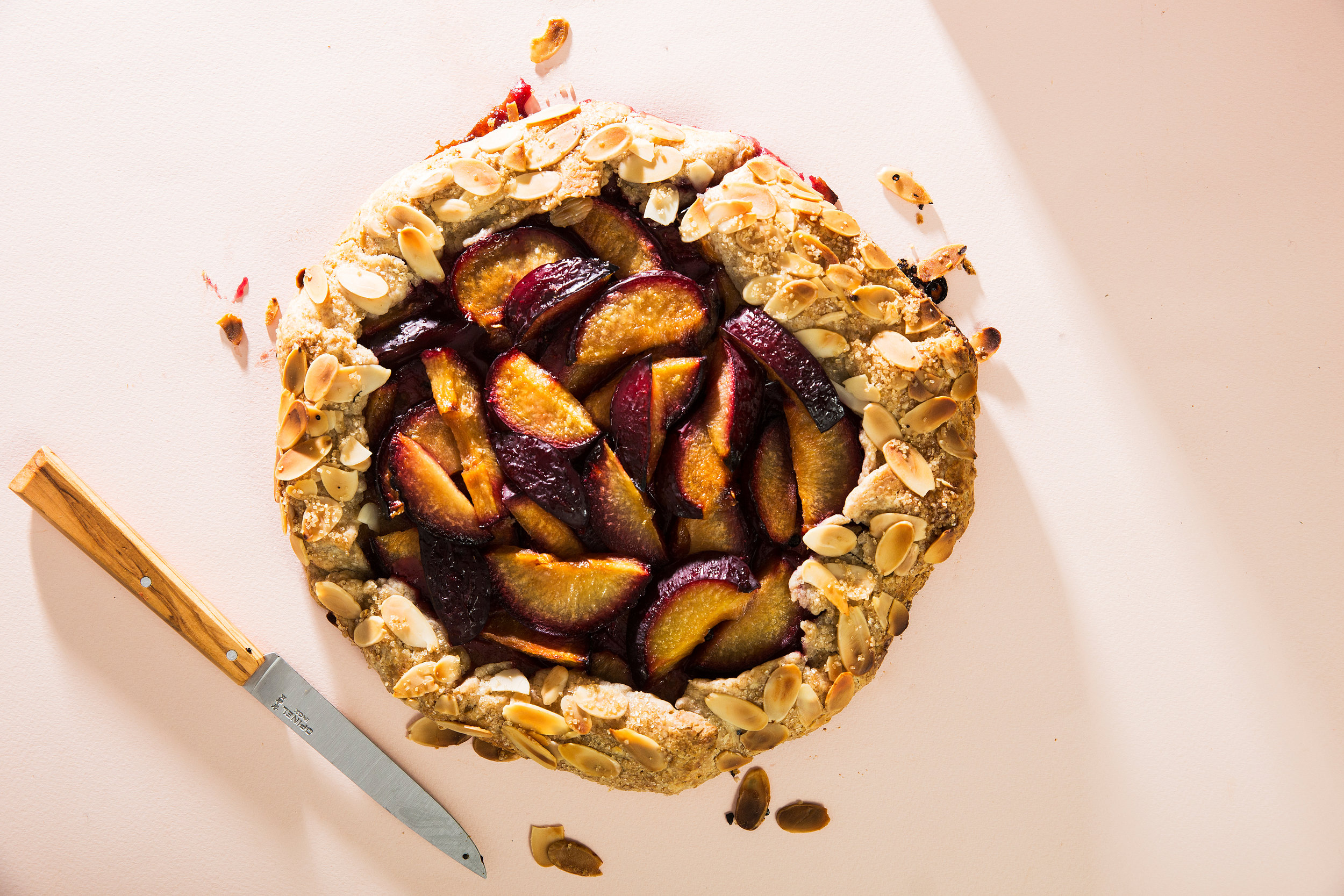The Season of Stone Fruit
/Sweet and savory recipes to capture summer’s gems
By Emily Connor, EdibleDC contributor, photography by Jennifer Chase, EdibleDC
My mind races at the first sight of stone fruit at my neighborhood farmers market. Peaches, plums, nectarines, apricots—they represent the peak of summer and, for a recipe developer, endless possibilities. Each weekend, I leave the market laden with as much fruit as I can carry, and then hurry back the next weekend to stock up anew.
I do this confidently: There are so many delicious, unexpected ways to enjoy stone fruit all season long—from peaches piled high in big, wooden crates week after week to the ephemeral season for apricots and plums. And what’s better than eating a fresh peach or plum out of hand, letting the sticky-sweet juices drip down your chin? Well, obviously nothing. However, I’m here to tell you that stone fruits are most exciting when brought to the plate. Each summer is an adventure for me; I can’t wait to explore market-fresh stone fruit’s potential in simple dishes that emphasize both its range and depth.
Here are four of my favorite recipes (two savory and two sweet) for showcasing summer’s stone fruit. As these recipes show, the orchard’s juicy orbs are equally suited for getting charred and deeply caramelized over an open flame for a hearty panzanella as they are for slicing and piling atop a rich, creamy labneh panna cotta. They’re equally at home in a spunky, no-cook, Thai-inspired salad as they are when baked inside a flaky, almond-shingled galette served warm at your next backyard barbecue.
This grilled peach salad is delicious for a summer lunch or dinner.
Varied as they are, these recipes have one thing in common: They require minimal fuss for maximum reward—my guiding mantra for summertime cooking.
Better yet, there’s absolutely no need to worry about finding an elusive perfect peach, or waiting until your plums or apricots are at peak ripeness. In the spirit of the lazy days of summer, use stone fruit interchangeably (or in combination) in any of these recipes. Bottom line? Let their varying levels of sweetness, tartness and ripeness inspire you
Grilled Peach Panzanella
Serves 4
This peachy spin on panzanella, the Tuscan bread salad traditionally made with tomatoes and stale bread, is one of my summertime staples when it’s too hot and humid to even think about turning on the stove. Charred peaches, salty prosciutto, creamy mozzarella, crispy croutons and a spunky chopped pesto vinaigrette—what’s not to love? It’s tailor-made for eating al fresco, glass of rosé in hand.
Olive oil for grilling
4 slices (½-inch each) from a loaf of crusty bread (such as ciabatta or sourdough)
4 large peaches, halved (pits removed)
3 ounces prosciutto
6 to 8 ounces mozzarella, torn into bite-sized pieces
A big handful of basil and mint, roughly torn
Sea salt and freshly ground black pepper
Chopped pesto vinaigrette
2 tablespoons pine nuts
2 tablespoons shaved or coarsely grated parmesan
1 cup fresh basil leaves, packed
5 tablespoons extra-virgin olive oil
2 tablespoons lemon juice, from 1 large lemon
Sea salt + freshly ground black pepper
To make the chopped pesto vinaigrette: Mound pine nuts and parmesan together on a cutting board and finely chop. Add the basil and continue chopping. Aim for a fine yet varied texture. Immediately transfer to a bowl and add extra-virgin olive oil so the basil doesn’t discolor. Add lemon juice, sea salt and black pepper, whisking to combine. Adjust seasoning and acidity, to taste.
Prepare a gas grill with all burners on medium, or a charcoal grill with hot coals. Brush the rack with olive oil.
Brush both sides of the bread with enough oil to thoroughly and evenly coat. Grill the bread a few minutes per side (checking frequently) or until charred in spots but still soft in the middle. Let the bread cool, then cut into ½-inch cubes.
After the bread comes off the grill, brush the peach halves lightly with oil and grill, flesh side down, until deeply caramelized.
On a large serving platter, arrange the grilled peaches, bread cubes, prosciutto, torn mozzarella and herbs, then drizzle with the chopped pesto vinaigrette and season, to taste, with salt and black pepper. Serve slightly warm or at room temperature.
Thai Salad with Apricots, Chiles and Cucumber
Serves 2 to 4
This savory, spicy, sweet Thai-inspired salad checks all of the flavor and texture boxes I want in a good salad. It’s great on its own as a light lunch, or as a side to grilled meat or fish. For a completely different, no less delicious take, chop all of the ingredients (versus slice) and serve more salsa-style. No matter which way you go, you’ll be very glad to have this no-cook gem in your summer repertoire.
3 apricots, thinly sliced
4 Persian cucumbers, thinly sliced on the diagonal
1 red chile, diced
3 tablespoons peanuts (I use roasted and salted), roughly chopped
A big handful of fresh mint and cilantro leaves, roughly chopped
Fish sauce vinaigrette
2 tablespoons fish sauce
1 tablespoon light brown sugar
1 tablespoon water
Finely grated lime zest
1 tablespoon lime juice
To make the fish sauce vinaigrette: Combine all ingredients in a jar with a tight-fitting lid. Shake until the sugar is dissolved. Adjust acidity, to taste.
In a bowl, combine apricots, cucumbers, chile and fish sauce vinaigrette. Marinate for 10 to 20 minutes. When ready to serve, add the peanuts and herbs. Serve the salad on a large platter or individual plates, using a slotted spoon to drain off the vinaigrette.
Labneh Panna Cotta with Peaches and Pistachios
This next-level panna cotta, adorned with peaches, crushed pistachios and a drizzle of good honey, is one of the simplest, most elegant desserts of summer. It’s impossibly tangy, rich and creamy from labneh, a thick, strained yogurt that’s used across many Middle Eastern cuisines. If you can’t find labneh, use an equal amount of Greek yogurt.
16 ounces labneh
3 tablespoons cold water
1 envelope unflavored gelatin (2¼ teaspoons)
1 cup heavy cream
⅓ cup granulated sugar
1 tablespoon vanilla extract
2 peaches, thinly sliced
2 tablespoons pistachios, roughly chopped or crushed
Honey, a good floral type, for drizzling
Place the labneh in a large bowl. Whisk several times until smooth and creamy. Set aside.
Place 3 tablespoons of cold water in a small bowl. Sprinkle gelatin on top and let soften for 5 minutes.
In a small saucepan over medium heat, warm the heavy cream and sugar, stirring until the sugar dissolves. Remove from heat just before the mixture reaches a simmer. Add the gelatin mixture immediately to the pan, whisking until the gelatin completely dissolves. Whisk in the vanilla.
Pour the warm cream mixture into the bowl containing the labneh. Whisk to evenly combine.
Divide the mixture evenly among 6 (6-ounce) jars or ramekins. Cover with plastic wrap and chill until firm, about 3 to 4 hours.
Top each panna cotta with sliced peaches, pistachios and a generous drizzle of honey. Serve.
Plum Galette with a Rye-Almond Crust
To me, there’s no better way to showcase summer’s most beautiful plums than in a rustic galette. The crust is amazingly flaky and almost cookie-crisp from a fancy-sounding yet simple French technique called fraisage, which involves nothing more than smearing the dough on the counter a few times. The smearing process creates long layers of butter in the dough, which translates to long flaky layers in the cooked crust. To make a good thing even better, sprinkle the dough with finely ground almonds before adding the plum filling (the almonds absorb excess juice as the plums bake) and top the folded edges with sliced almonds for added flavor and texture.
For the rye-almond crust:
1 cup (120 grams) unbleached all-purpose flour
½ cup (60 grams) rye flour
¾ teaspoon kosher salt
10 tablespoons unsalted butter, cut into small pieces
3 to 6 tablespoons ice water
For assembly:
4 to 6 plums (about 1½ pounds), pitted and cut into wedges (no need to peel)
⅓ cup granulated sugar
Finely grated zest from 1 large lemon
2 tablespoons almond flour (or finely ground almonds, pulsed in a food processor)
3 tablespoons sliced almonds
1 tablespoon turbinado sugar
1 to 2 tablespoons heavy cream (or an egg white, lightly beaten)
Heat oven to 400°F.
To make the almond-rye crust, in a food processor pulse the flours and salt to combine. Scatter butter pieces over the flour mixture, then pulse until the butter is the size of large peas, about 6 to 8 pulses. Sprinkle 2 tablespoons of water over mixture and pulse a few times, then repeat with 1 tablespoon of water at a time, or just until small curds start to form and dough holds together when pinched with fingers. (Alternatively, you can do this by hand.)
Empty dough onto clean counter or piece of parchment paper. Using bench scraper, gather dough into a rough rectangular mound about 12 inches long and 4 inches wide. Starting from the farthest end, use the heel of your hand to smear about one sixth of dough against your work surface away from you. Repeat until all of your dough has been smeared. Using bench scraper, gather the dough again into a 12-inch-long and 4-inch-wide mound and repeat smearing of dough with heel of hand. The dough should be smooth and cohesive at this point; if not, repeat smearing process again. Form dough into 4-inch disk, wrap in plastic and refrigerate until firm, about 1 hour.
To assemble the galette: In a large bowl, mix together plums, sugar and lemon zest; set aside.
Remove the dough from the refrigerator. Roll out dough into a 12-inch round. Transfer dough onto a large parchment-lined baking sheet. Sprinkle the almond flour evenly over the dough, then mound the plums in the middle, leaving a 2½-inch border around the edges. Fold the edges of the dough over the filling. (If your dough is getting too warm at any point and is difficult to manage, return it to the refrigerator for 10 to 15 minutes, then proceed.) Brush the folded edges with heavy cream (or egg wash), then sprinkle them with almonds (pressing to adhere as needed) and turbinado sugar.
Bake for 40 to 45 minutes, until fruit is bubbling and the crust is golden. Cool for at least 30 minutes on wire rack. Serve warm or at room temperature.








